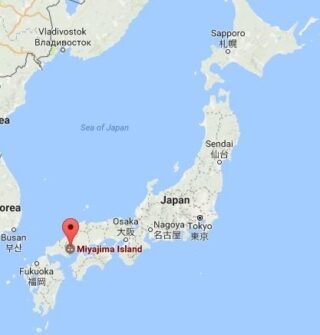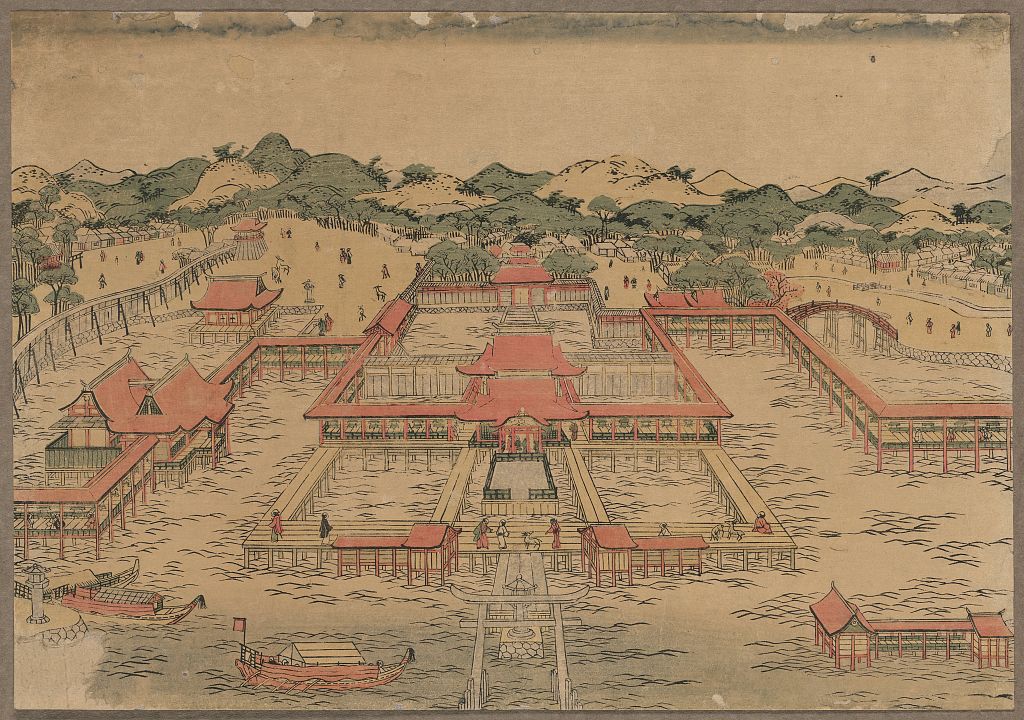Continuing our journey, we head to Miyajima Island which is located in Hiroshima Harbor in a quiet stretch of the Seto Inland Sea. The term Itsukushima, with which it was formerly called, means “guarded island”, while that of Miyajima, now better known, means “sanctuary island”, but also “elegant, noble island”.
This refuge for sailors, merchants and powerful men has always been considered sacred: the Shinto shrine with its monumental gate was built on the sea, on wooden poles, in order to prevent visitors from trampling the soil of this celestial island, more heavenly than earthly.
The portal, called torii or otorii in an honorific sense (the “honorable gate”), separates the sphere of the human from that of the divine and the kami. Passing through it has a purifying value – as always when crossing the threshold of a Shinto shrine -, but also auspicious: in precious vermilion red lacquered wood, the door is a good omen, like a blazing dawn.
 Credits: Jacqueline Macou da pixabay
Credits: Jacqueline Macou da pixabay
The sanctuary is also of the same color and represents, with its delicate structure, an example of a fusion between architecture and the natural environment. The vivid red creates a pleasant contrast to the bright green of the vegetation and the dazzling blue of the sea. The shrine and the gate have been declared a World Heritage Site by UNESCO.
The magic of Miyajima is given by the phenomenon of the tides that rise and fall according to the hours of the day, as is the case for Mont Saint-Michel in Normandy. At times of high tide, it is possible to cross the otorii gate by boat, while at low tides that gate can be reached from the island by walking on the very white sandy floor of the ocean. The sea appears and disappears, as in a spell created by the moon.
 Low tide in Miyajima. Credits: Samuele Schirò da pixabay
Low tide in Miyajima. Credits: Samuele Schirò da pixabay
This mysterious and fascinating place has always been guarded by the deer. These gentle but at the same time courageous animals watch over the island and are said to be messengers of the kami. It is possible to meet them walking through the streets of the inhabited center, as they roam freely. Following a fawn that leaps into the mountains of Miyajima, covered with pristine vegetation, it is possible to contemplate the primordial scenery of the vast and placid ocean.
Among the attractions of the island, in addition to the sanctuary, there are the temple of Daishoin on Mount Misen, immersed, in the autumn season, in golden maple forests, the Gojunoto pagoda and the Senjokaku or “hall of a thousand mats”, built by leader Toyotomi Hideyoshi (1537-1598) as a grandiose pavilion from which to enjoy a splendid view of the ocean. The island’s specialties are oysters and momiji manju, sweets in the shape of a maple leaf. Miyajima is also the island of music: the Daiganji temple is dedicated to the goddess of music and in the nearby shrine, performances of traditional music and gagaku court dance are held a few times a year.
Utagawa Toyoharu, A Perspective Picture of Itsukushima Shrine, XVIII-XIX century, Library of Congress, Washington, D.C.
In this ukie print, the bird’s eye perspective merges with the western perspective view, giving us a panoramic view of the sanctuary and the island. The architecture of the sanctuary, in Kyōto’s shinden zukuri style (12th century), consists of several pavilions connected by delicate scaffolding and corridors which, delimited by slender columns, create spectacular cloisters made of water. Made up more of emptiness than of matter, the building is permeated by air and light and seems to float on the waves: it is said to have been built on a sea of clouds.
Utagawa Hiroshige, Itsukushima in Aki Province, from the series Three Views of Japan, ca. 1855, Brooklyn Museum, New York
In Hiroshige’s uchiwae fan that we show, the torii, seen foreshortened, boldly cuts the image and seems to want to go beyond its borders, with a surprising 3D rendering. On the mountain ridges, where the Gojunoto pagoda is visible, the trees, of a velvet green, are depicted one by one, as in an embroidery. Both the temple and the boats in the distance float on the water and everything is enveloped by the silence, of a deep blue, of the night.
Utagawa Kunisada, Miyajima in the Aki Province, ca. 1825, Rijksmuseum, Amsterdam
In this print, the asymmetrical construction of the image cuts away what is not essential. It gives us only a partial view of the door and the boat that is passing through it, in order to give the viewer the idea of the movement of the boat that seems to come out from the edges of the image, sliding away quickly on the water. It is the snapshot of a fleeting moment, the one in which a spiritual world is left to return to the material world; an ephemeral moment like the cherry blossoms that decorate the hairstyles of the two women, one of whom looks in admiration, for the last time, at the grandeur of the torii. In the background, a stylized representation of the sanctuary, mountains, and clouds.
Kawase Hasui, Miyajima in the Mist, 1947, Rijksmuseum, Amsterdam
In this shinhanga print, layers of vaporous mist envelop the Itsukushima Shrine and the slopes of the mountains, creating a dramatic effect. The outlines of things appear attenuated and evanescent.
Kawase Hasui, Miyajima Shrine in Snow, ca. 1935, The Art Institute of Chicago, Chicago
Here the sanctuary is wrapped in soft snow that continues to fall in dancing flakes on the water. The otorii door, with the gray sky and mountains on the horizon, are reflected in the blue transparencies of a crystal ocean.
Kawase Hasui, Snow at Miyajima Shrine, ca. 1930, Minneapolis Institute of Art, Minneapolis
Here, through the trees, you can have a close-up view of the door with a continuum of sea and sky interrupted only by white snow.
Kawase Hasui, Clearing after a Snow, Miyajima, XX century, The Art Institute of Chicago, Chicago
After a heavy snowfall, the author has captured the moment of the weather clearing, when the thin and glacial air, crossed by rays of the sun, becomes opalescent.
Kawase Hasui, Snow at Itsukushima, 1932, The Art Institute of Chicago, Chicago
In front of the torii, stands one of the magnificent granite lamps that adorn the shrine. As a symbol of enlightenment, the lamp represents deep understanding of reality and wisdom. The cool colors are enlivened by the fiery red of the door.
1936, The Art Institute of Chicago, Chicago
Perhaps because the tides are a lunar phenomenon, many images of Miyajima are nocturnal with the moon. From the cloister of the sanctuary, seen from a foreshortening and scattered with lighted lamps, the moon appears to emerge in a cloud gap. Just as the lamps seem to draw light from the star, the sky and the ocean are also illuminated. The majestic torii is in the background.
Ohara Koson, Moon, Deer, Miyajima, ca. 1910
In this print the moon, as a celestial lamp, envelops everything with its silver light. Even deer are drawn to the sunning scenery and stand out against the sky with their majestic posture. There is no distinction between ocean and clouds.
Kawase Hasui, Starlit Night at Miyajima, from the series Souvenirs of Travel III, 1928, Museum of Fine Arts Boston, Boston
Like some kind of distant celestial flames, even the stars have exerted a fascination in the Japanese imagination. The starlight sky radiates different shades of luminous blue over the mountains and the sea.
For further information on Japanese art, see Maria Teresa Lattarulo, L’arte figurativa giapponese. Fiori, bellezze, visioni. 1400-2000, Progedit, 2021, https://www.progedit.com/pro…/larte-figurativa-giapponese/
https://www.amazon.it/figurativa-giapponese-bellezze-visioni-1400-2000/dp/8861945198/
https://www.lafeltrinelli.it/libri/maria-teresa-lattarulo/l-arte-figurativa-giapponese-fiori/
https://www.mondadoristore.it/arte-figurativa-giapponese-Maria-Teresa-Lattarulo/eai978886194519/
Copyright © arteingiappone – All rights reserved
Credits: geographical map from www.worldeasyguides.com











